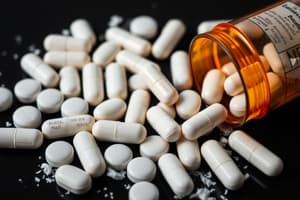Podcast
Questions and Answers
What percentage of adults aged 16 to 24 years were classified as 'frequent' drug users?
What percentage of adults aged 16 to 24 years were classified as 'frequent' drug users?
- 3.5%
- 2.1%
- 4.3% (correct)
- 5.0%
Which of the following substances is classified as an opioid?
Which of the following substances is classified as an opioid?
- Methamphetamine
- Cocaine
- MDMA Ecstasy
- Heroin (correct)
Which of the following is a critical consideration when addressing drug use?
Which of the following is a critical consideration when addressing drug use?
- Social pressure handling
- Minimizing harm only
- Treatment interactions (correct)
- Identification of recreational users
What is one of the first steps in preventing substance abuse?
What is one of the first steps in preventing substance abuse?
Which method of intake is commonly associated with Cocaine?
Which method of intake is commonly associated with Cocaine?
What percentage of adults aged 16 to 24 years reported taking a drug in the last year?
What percentage of adults aged 16 to 24 years reported taking a drug in the last year?
What is one of the key roles of dental care professionals regarding substance misuse?
What is one of the key roles of dental care professionals regarding substance misuse?
What percentage of adults aged 16 to 59 years had taken a Class A drug in the last year?
What percentage of adults aged 16 to 59 years had taken a Class A drug in the last year?
Which outcome emphasizes recognizing psychological and sociological factors related to oral health?
Which outcome emphasizes recognizing psychological and sociological factors related to oral health?
Why is it important for dental care professionals to systematically examine patients?
Why is it important for dental care professionals to systematically examine patients?
What is one intended learning outcome related to the impact of illegal drugs?
What is one intended learning outcome related to the impact of illegal drugs?
What percentage of adults aged 16 to 24 years reported taking a Class A drug in the last year?
What percentage of adults aged 16 to 24 years reported taking a Class A drug in the last year?
What aspect of care is emphasized in the outcomes for making follow-up arrangements?
What aspect of care is emphasized in the outcomes for making follow-up arrangements?
Flashcards
Cannabis
Cannabis
A drug that can be smoked, vaped or eaten. It can cause a range of effects including relaxation, paranoia, and impaired memory.
Methamphetamine
Methamphetamine
A powerful stimulant that can be snorted, injected or smoked. It can cause a range of effects including increased energy, alertness, and anxiety.
Cocaine
Cocaine
A potent stimulant that can be snorted, injected, or smoked, causing a range of effects including euphoria, increased energy, and paranoia.
Heroin
Heroin
Signup and view all the flashcards
MDMA/Ecstasy
MDMA/Ecstasy
Signup and view all the flashcards
GDC Learning Outcomes
GDC Learning Outcomes
Signup and view all the flashcards
Systematic Clinical Examination
Systematic Clinical Examination
Signup and view all the flashcards
Patient Oral Health Status Changes
Patient Oral Health Status Changes
Signup and view all the flashcards
Follow-Up Care
Follow-Up Care
Signup and view all the flashcards
Preventive Approach in Oral Health
Preventive Approach in Oral Health
Signup and view all the flashcards
Health Risks of Drugs, Alcohol, and Tobacco
Health Risks of Drugs, Alcohol, and Tobacco
Signup and view all the flashcards
Effective Communication in Dentistry
Effective Communication in Dentistry
Signup and view all the flashcards
Drug Misuse Prevalence in the UK
Drug Misuse Prevalence in the UK
Signup and view all the flashcards
Study Notes
Recreational Drugs/Substance Misuse in Dentistry
- The presentation is about recreational drugs/substance misuse and its relevance to dentistry.
- This includes psychological and sociological factors affecting oral health, disease progression, and treatment success.
- Key aspects of clinical examinations are crucial for proper diagnoses and assessments.
- Identifying any changes in a patient's reported oral health and reacting accordingly is necessary.
- Referring patients to other dental team members or health professionals when needed is a critical part of care.
- Following up with patients appropriately is important for their ongoing care.
- Preventive care should be a fundamental part of patient treatment, contributing to long-term oral and general health.
- Understanding the health risks of diet, drugs (including tobacco and alcohol), and substance misuse is vital for effective patient education and support.
- Effective communication is necessary for patients, their representatives, and the general public, especially during sensitive situations.
Intended Learning Outcomes
- Students will outline the relevance of drug misuse to the UK population, considering prevalence.
- They will develop and demonstrate the role of dental care professionals for delivering key general health messages.
- They will evaluate data and provide appropriate advice to patients, and identify areas needing further attention.
- They will discuss the impact of common illegal drugs on oral and general health.
Assessment
- Formative and summative assessments are planned.
- Unseen cases and class discussions will be used, along with clinical activities.
- Case presentations will also contribute to assessment.
Recall of Information
- The presentation includes visuals of teeth and dental procedures along with patient record-keeping.
Office for National Statistics Data
- One in five adults (aged 16-24) has used a drug in the past year (around 1.3 million people) and 3.4% of adults between 16 and 59 have used a Class A drug in the last year.
- 7.4% of adults aged 16 to 24 took a Class A drug (approximately 467,000 people).
- 2.1% of adults aged 16–59 and 4.3% of adults aged 16–24 are considered frequent drug users (using drugs more than once a month in the past year).
Types of Substance Users
- Social, Abuser, Addict.
Types of Drugs Discussed
- The presentation covers numerous recreational drugs, including:
- Cannabis
- Methamphetamine
- Cocaine
- Heroine
- MDMA Ecstasy
- Nitrous Oxide
Drug Information
- There are sections on caffeine and energy drinks, synthetic cannabinoids (K2/spice), and the differences between these and other substances
- The presentation discusses the chemical structures and classifications of various substances.
- These substances can cause various adverse effects on both oral and general health.
Drug Wheel
- A drug wheel is included, categorizing various substances based on their effects.
- Substances like cannabinoids, opioids, stimulants, depressants, dissociatives, and psychedelics are included.
Things to Consider
- Treatment/drug interactions
- Asking relevant questions
- Prevention
- Sensitive Communication
- Identification (E/O & I/O)
Impact on Oral Health & General Health
- The negative impact of these substances on oral health and general health, such as dry mouth, increased risk of gum disease, periodontal issues, and related health problems.
- Issues like burns and changes in oral tissues are also considered.
Resources for Information
- Materials and links to resources like FRANK and The Drugs Wheel were presented.
Criteria for Mind Mapping
- Detailed criteria for mind mapping each drug were provided, including alternative names, intake methods, oral health impact, and general health impact.
Studying That Suits You
Use AI to generate personalized quizzes and flashcards to suit your learning preferences.




